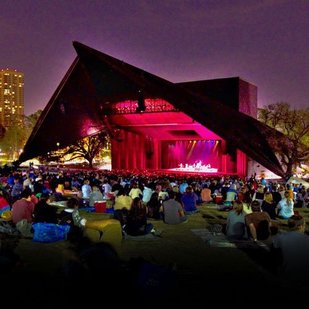 The Miller Outdoor Theatre, in Hermann Park.
The Miller Outdoor Theatre, in Hermann Park. Perhaps I should say that I approach outdoor performances with some trepidation. I’ve come to expect they are likely to be compromised artistic experiences: compromised by the weather (too hot, too cold, raining), by an erratic, snap-crackle-pop sound-system, by extraneous noise, or a by distracted, indifferent audience. Such obstacles can lead to second-rate performances, with artists struggling in less-than-ideal conditions, wishing they were somewhere else.
But the night was beautiful, the audience was attentive, the sound-system was excellent, and the performance was first rate. This is a fully committed production: none of the artists involved seemed to think they were “just” doing an outdoor show for the unwashed masses.
I hesitate to go into too much detail about the singers’ vocal abilities, because they were heavily amplified. (Even Andrea Bocelli sounds splendid in front of a microphone, if you get my drift.) However, I can say with certainty that everyone on stage sounded great: with powerful verismo delivery, soaring above the orchestra in all registers.
As Tosca, soprano Kelly Kaduce was everything a Tosca should be: intense, mercurial and emotionally very available. She has a rather wide vibrato, which sometimes threatened to swallow up whatever note she was singing. But she met the vocal demands of her role with a glorious outpouring of sweeping phrases.
Chad Shelton fully inhabited the role of Mario. He displayed a rough-hewn tenor voice, with glottal stops and breaks in register, which may have been emphasized by the sound-system. Yet he made good use of these qualities for dramatic impact.
Baritone Weston Hurt, as Baron Scarpia, made the most of his rich, sonorous baritone. His characterization was unusual and intriguing: at times, he turned the opera’s villain inward, making him a man of introspection, not just a man of action. As well, Hurt’s willingness to show his arm, amputated above the elbow, in a short-sleeved shirt made his Scarpia look like a tough guy with a nasty history.
Among the smaller roles, I especially enjoyed tenor Chris Bozeka as Spoletta. He was a thoroughly creepy figure, and made every scene he appeared in just a little bit creepier.
The production, originally staged by director John Caird and re-staged by Omer Ben Scadia, was updated to the early 20th century. It’s an action-packed staging, at times downright violent, and spiced up with some clever ideas.
Scarpia is portrayed as an art collector: his apartment in the Farnese Palace is crammed full of sculptures, many still in crates. (It’s hard not to suspect that the collection is ill-gotten. I really don’t think he bought it all on eBay.) And when he gives the order to hang the dead body of poor Angelotti, in this production it’s actually done on stage – and the corpse dangles ominously over the whole final scene. I’m not sure, however, why Tosca had to slit her own throat before jumping to her death. That was overkill (literally).
Under maestro Bradley Moore, the HGO Orchestra sounded absolutely fabulous. Moore briskly moved the piece forward, and his players responded nimbly to his every shift in tempo and dynamic.
A final note, to my readers in Toronto: Why, after so many years of talking about it, is there still no outdoor summer venue for the Toronto Symphony and the Canadian Opera Company? I recall an attempt, more than a decade ago, to establish such a thing in the Niagara Region, which was stopped by local residents. Maybe it’s time for a fresh initiative.
© Colin Eatock 2016
 RSS Feed
RSS Feed

